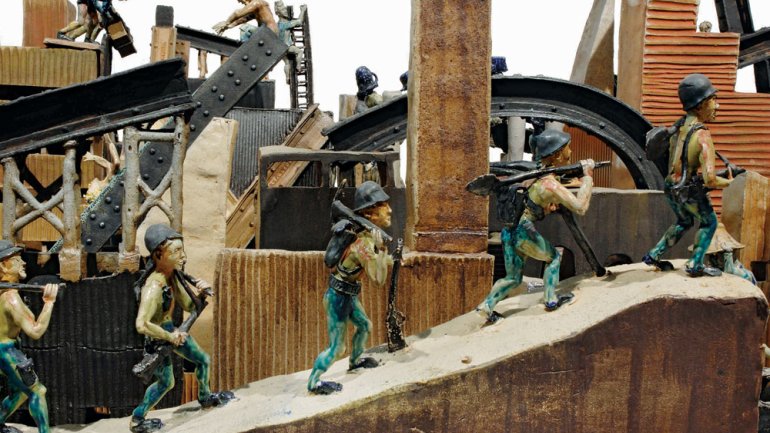Urban Epic
Urban Epic
Museum of Art
Rhode Island School of Design
Arnie Zimmerman: Inner City
Providence, RI
Sept. 25, 2009 – Jan. 3, 2010
risdmuseum.org
Inner City combines two important aspects of Arnie Zimmerman’s ceramic oeuvre: his architectural interests, represented by the large carved vessels he produced in the 1980s, and the intimate groupings of figures he focused on beginning in the 1990s. This complex installation, whose gridlike framework was designed by the Portuguese architect Tiago Montepegado, spreads across a 4,000-square-foot space of the RISD Museum’s Chace Center galleries, comprising more than 150 figures and architectural elements. There are pedestals of varying heights, components attached to walls and viewing ramps. This isn’t the men’s first collaboration: Montepegado’s base for a group of figures shown in Lisbon in 2004 gave Zimmerman the idea for Inner City. It “made me realize that
I wanted to push the narrative with the small figures into a context that confronts the viewer the way architecture does.” They constructed versions of Inner City that were displayed in Lisbon in 2007 and in Leeuwarden, the Netherlands, in 2008. Zimmerman says, “Tiago serves as master city planner to my role as the creator of little people, buildings and other objects.”
Out of stoneware clay, glaze and epoxy, Zimmerman has devised a miniaturized urban panorama, resembling the densely populated scenes in the paintings of Brueghel or Bosch, but also evocative of the style of some WPA artists of the New Deal. The diminutive stoneware tenements, skyscrapers, scaffolding and trestles are teeming with figures (more like figurines) of workers, who dumpster dive, build, rest, eat and brawl. There’s an antic side to these tableaux—some figures have pots or saucepans on their heads—but the vision is ambiguous. There’s vitality, but is it bringing progress or repetitive toil?
Zimmerman has noted that in the RISD Inner City, he worked more on architectural forms and less on the figure, an attempt at “architectural diversity,” reflecting the New York City he has lived in for over 25 years. He is commenting on the relentless pace of tearing down and building that can obliterate neighborhoods even as it brings forth new streetscapes. “The parts of the city I was most familiar with when I first arrived had a visceral, palpable connection to the past,” Zimmerman says. “Over the past few decades, New York City has irrevocably changed into a different urban environment—something more civil and benign, more bland and corporate.”
A 42-page catalog, with texts by curator Judith Tannenbaum and Arnie Zimmerman, is $16.50, www.risdworkscom.

